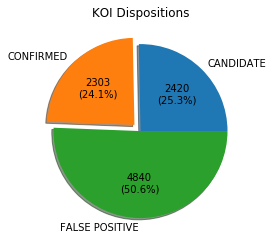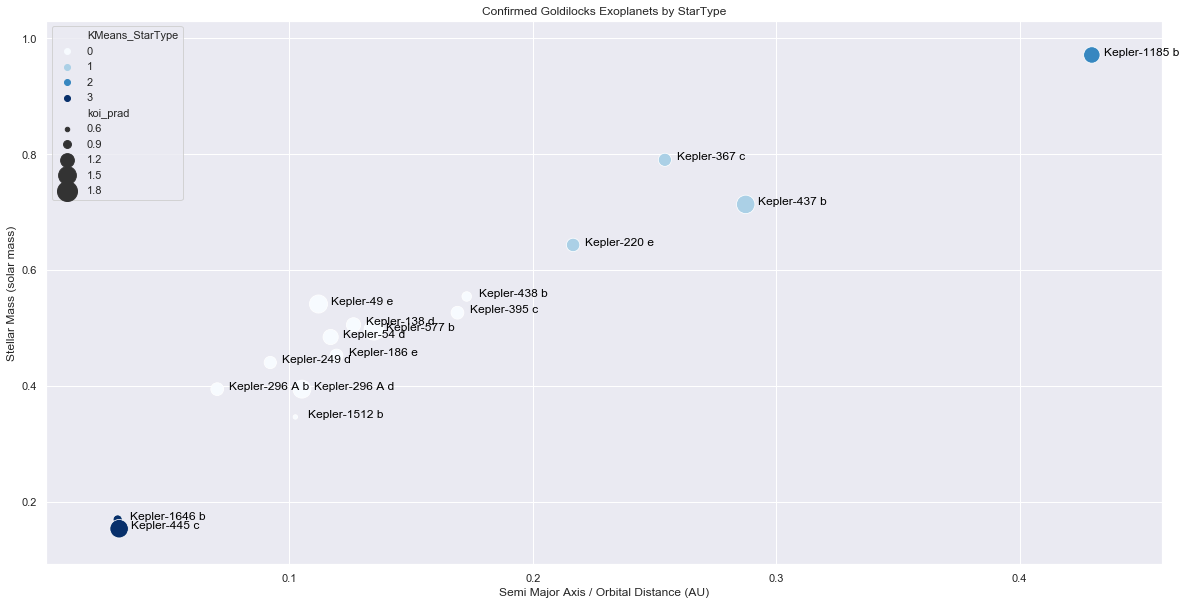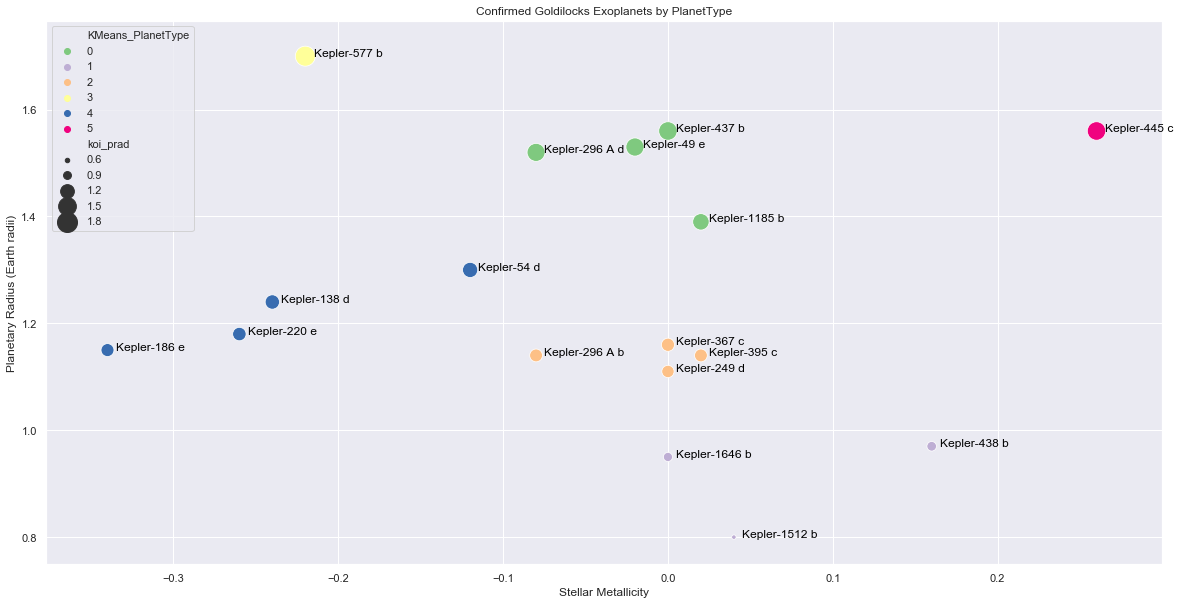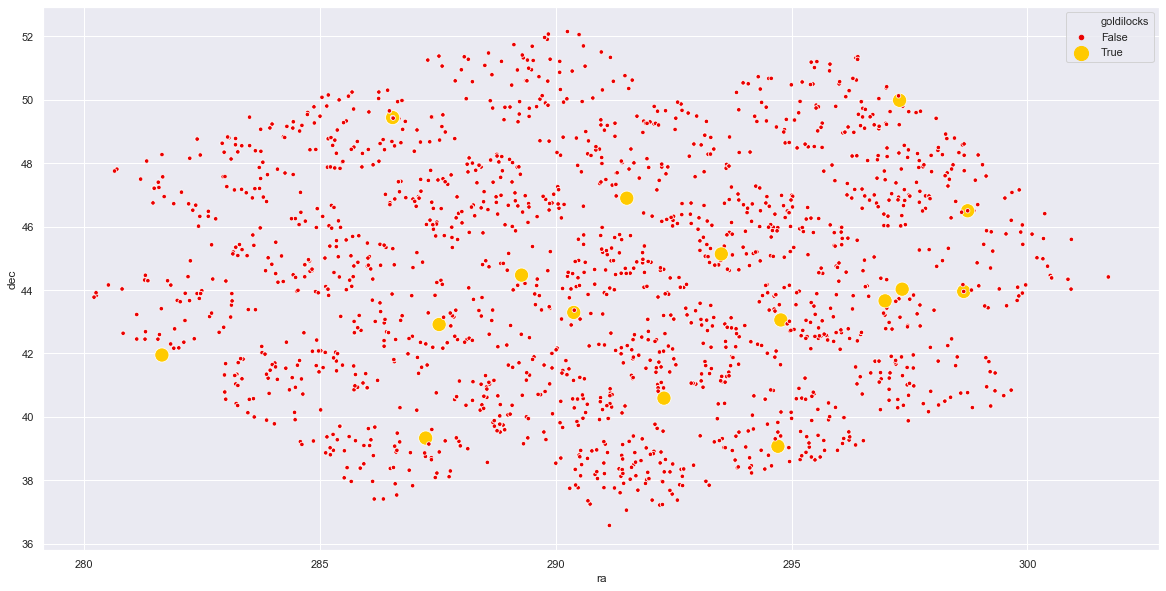The Kepler Space telescope was designed to survey a small section of the sky (105 deg^2 = 1/400th of sky), using the transit method to discover Earth-size exoplanets in or near habitable zone and estimate how many stars in the Milky Way have such planets.
During its over nine and a half years of service, Kepler observed 530,506 stars and detected 2,662 planets.
- 0_Keplar_Tabular_View.ipynb
- 1_Exoplanet_Archive_Information.ipynb
- 2_Disposition_Correlations.ipynb
- 3_Disposition_Prediction_Fastai_1_Subsection.ipynb
- 3_Disposition_Prediction_Fastai_2_Full_Table.ipynb
- 4_Starmap.ipynb
- 4_Stellar_Scatter_Plots.ipynb
- 5_Exoplanet_Habitability.ipynb
-
Dataset:
- Data Source: https://exoplanetarchive.ipac.caltech.edu/cgi-bin/TblView/nph-tblView?app=ExoTbls&config=cumulative
- ./data/kepler_koi.csv = CSV, All Columns, All Rows, Values Only
- Column Defintions: https://exoplanetarchive.ipac.caltech.edu/docs/API_kepcandidate_columns.html
- Data Source: https://exoplanetarchive.ipac.caltech.edu/cgi-bin/TblView/nph-tblView?app=ExoTbls&config=cumulative
-
Kepler Information:
- Other Kepler Datasets: https://exoplanetarchive.ipac.caltech.edu/docs/ICEexohelp.html
- Kepler NASA Mission Page: https://www.nasa.gov/mission_pages/kepler/main/index.html
- Wikipedia - Kepler Space Telescope: https://en.wikipedia.org/wiki/Kepler_space_telescope
-
Exoplanet Information:
- Youtube - How to Find an Exoplanet: https://www.youtube.com/watch?v=ahX_0XHp1vM
- Transit Method - Light Curve Tutorial: https://www.cfa.harvard.edu/~avanderb/tutorial/tutorial.html
- Methods of Detecting Explanets: https://www.planetary.org/explore/space-topics/exoplanets/how-to-search-for-exoplanets.html
- Notebook: 0_Keplar_Tabular_View.ipynb
- Preprocessing code: ./src/dataset_koi.py
Preprocessing:
- Dataset was split by columns into conceptual groupings (
id,archive,disposition,transit,TCE,stellar,KIC,pixels) based on the dataset column definitions - Pandas datatypes where manually assigned to columns where autodetection failed:
category,datetime64,uint8 .fillna(0 or '')was applied to a small number of columns:koi_score,koi_comment,koi_tce_delivnamekoi_fpflag_ntcontained an erroneous 4, thus needed to be mapped back to a boolean int- 4 categorical columns contained quarterly timestamp information such as
q1_q17_dr25_stellarwhere simplified via regexp:re.sub(r'_(q|dr)\d+|(q|dr)\d+_', '', str) - 14 columns contained either only NaNs or a single value, thus where excluded as they contained no useful information
- 2 columns contained URL data, which was excluded as being irrelevant to the current exploration
OneHot Encoding 2_Disposition_Correlations.ipynb:
koi_dispositionwas OneHot encoded usingpd.get_dummies()for correlation analysiskoi_commentwas string split on '---' and OneHot/Binary encoded into 124 unique comment_flag columns
- Notebook: 1_Exoplanet_Archive_Information.ipynb
Basic Statistics:
- Number of KOIs 9564
- Number of Solar Systems 8214
- Number of Named Planets 2305
KOI Dispositions:
Questions and Answers:
- Are All Named Planets Confirmed?
- There are two named false positives: Kepler-469b + Kepler-503b
- Are Confirmed Planets Named?
- All confirmed planets have been named
Google Fu has a little more information on these named False Positives
Kepler-469 b: https://twitter.com/exohugh/status/1169262460504875008
Twitter: Hugh Osborn @exohugh - Sep 4, 2019He [Alexandre Santerne] also kills Kepler-469b which is a validated Kepler planet yet is clearly a binary fold in the wrong period. #PlatoESP
Kepler-503 b: https://arxiv.org/abs/1805.08820
arxiv: Kepler-503b: An Object at the Hydrogen Burning Mass Limit Orbiting a Subgiant Star
- Notebook: 2_Disposition_Correlations.ipynb
Observations:
-
In the vast majority of cases the presence of fpflags or comments is used to indicate the reason for a FALSE POSITIVE
- fpflags - only in 19 (0.2%) cases, does a single fpflag refer to a CONFIRMED or CANDIDATE exoplanets
- comments - only 1408 (10%) of comments are used in labelling CONFIRMED or CANDIDATE exoplanets
-
Correlation between fpflags
- There is mild anti-correlation between: koi_fpflag_nt + koi_fpflag_ss
- A Stellar Eclipse has Transit like properties
- There is high correlation between: koi_fpflag_co + koi_fpflag_ec
- A Centroid Pixel Offset is a common cause of Contamination
- There is mild anti-correlation between: koi_fpflag_nt + koi_fpflag_ss
-
Correlation of Comment Flags with Disposition
- The vast majority of comment flags are correlated with FALSE POSITIVE and half anti-correlated with CONFIRMED or CANDIDATE
- As observed above, 90% of comments are used to label FALSE POSITIVE
- The fields that most correlate with CANDIDATE, are also those which have the greatest difference in correlation with CONFIRMED
- These all seem to flag having too little information about a KOI
- According the documention, FALSE POSITIVE can occur when:
-
- the KOI is in reality an eclipsing binary star
-
- the Kepler light curve is contaminated by a background eclipsing binary
-
- stellar variability is confused for coherent planetary transits
-
- instrumental artifacts are confused for coherent planetary transits
-
- The FALSE POSITIVE flags seem to be related to tests for these conditions
- The CONFIRMED flags seem to be related to tests for ruling out these these conditions
- Notebook: 3_Disposition_Prediction_Fastai_1_Subsection.ipynb
- Notebook: 3_Disposition_Prediction_Fastai_2_Full_Table.ipynb
A machine learning Neural Network model was trained to predict KOI disposition, with:
- 83.3% accuracy - Using only fpflags and comments as input
- 89.6% accuracy - Using the full dataset
- Notebook: 4_Starmap.ipynb
Star Observations:
- The bottom right of the grid is closest to the Galactic Rim, thus has a greater overall star density
- Visually there appears to be a greater ratio of CONFIRMED to FALSE POSITIVE away from the Galactic Rim
Map Observations:
- Each square represents the stationary field of view of the Kepler Space Telescope
- Kepler was repointed 21 times in a grid search pattern during its 9 year mission
- The slight curvature of the grid represents the projection of a sphere onto a flat surface
- Notebook: 4_Stellar_Scatter_Plots.ipynb
Correlation with Laws of Physics:
-
As expected by the laws of physics (more fuel = hotter and bigger)
- Stellar Mass (koi_smass) is strongly correlated with Surface Temperature (koi_steff)
- Stellar Mass (koi_smass) is also correlated with Metallicity (koi_smet) and Radius (koi_srad)
- Radius (koi_srad) - and by extension Stellar Mass - is anti-correlated with log10 Surface Gravity (koi_slogg)
-
Differences in correlations between ALL -> CONFIRMED:
- Mass/Radius = increases in correlation
- Metallicity/Radius = uncorrelated for ALL | correlated for CONFIRMED
- Metallicity/Gravity + Temperature/Gravity = increase in anti-correlatedness
- Temperature/Radius + Temperature/Metallicity = anti-correlated for ALL | correlated for CONFIRMED
Metallicity vs Radius - correlated for CONFIRMED - uncorrelated for ALL

- Exoplanets are found more often around high-metalicity stars (more material for rocky planets)
- Large Red Giants have a minimum metalicity threshold (nuclear astrophysics)
Temperature vs Radius - anti-correlated for ALL | correlated for CONFIRMED

- Exoplanets are found more often around small low-temperature stars
A key goal of the Kepler Space Telescope is to determine how many Earth-size and larger planets there are in or near the habitable zone (often called "Goldilocks planets") of a wide variety of spectral types of stars.
We start with 2303 CONFIRMED exoplanets. Different planet types include:
- Super-Earth below 10$M_e$ with a radius of 0.8-1.25$R_e$ - exactly what we are looking for
- Earth Sized Ocean_planet would have a much lower density - but could potentually harbour life
- Carbon planet low density diamonds in the sky - may lack enough oxgyen to have water
- Gaseous Mini-Neptunes require a minimum radius of 1.7$R_e$
- Small Sub Earths under 0.8$R_e$, likely lack the gravity and magnetic fields to sustain a habitable atmosphere
- List of potentially habitable exoplanets only lists exoplanets in the range of 0.78-1.63$E_r$, which mostly agrees with the 0.8-1.7$E_r$ range suggested above
The first criteria for a earth-like habitable planet is liquid water, which would require a koi_teq Equilibrium Temperature (Kelvin) within the range 273.2K - 373.2K.
- Exoplanets that are too cold : 50 ( 2.17%)
- Exoplanets that are just right: 110 ( 4.78%)
- Exoplanets that are too hot : 2142 (93.01%)
Lacking a formal density measurement from the KOI table, the closest proxy is koi_prad Planetary Radius (Earth radii). Applying the range of 0.8-1.7$E_r$ as a second criteria:
- Exoplanets that are too small : 56 ( 2.43%)
- Exoplanets that are just right: 713 (30.96%)
- Exoplanets that are too big : 1550 (67.30%)
These limits can then be combined together:
- Exoplanets that are "just right" temp : 110 ( 4.78%)
- Exoplanets that are "just right" size : 713 (30.96%)
- Exoplanets that are "just right" combined : 17 ( 0.74%)
Names of potentually habitable exoplanets:
- Kepler-1185 b, Kepler-138 d, Kepler-1512 b, Kepler-1646 b, Kepler-186 e, Kepler-220 e, Kepler-249 d, Kepler-296 A b, Kepler-296 A d, Kepler-367 c, Kepler-395 c, Kepler-437 b, Kepler-438 b, Kepler-445 c, Kepler-49 e, Kepler-54 d, Kepler-577 b
Plotting the Goldilocks Exoplanets against Stellar Mass and Orbital Distance.
There is a strong linear correlation between the Stellar Mass (and by extension Surface Temperature), with the Orbital Radius of the Habitable Zone
Within the correlation, there still appears to be 4 distinct clusters, possibly indicating different classes of Red Dwarfs and Main Sequence stars
Plotting Planetary Radius against Stellar Metallicity, may provide insight groupings into planet composition, as high-metal stars are more likely to form rocky planets, rather than water/ice worlds or carbon planets
Location of goldilocks exoplanets in the night sky




